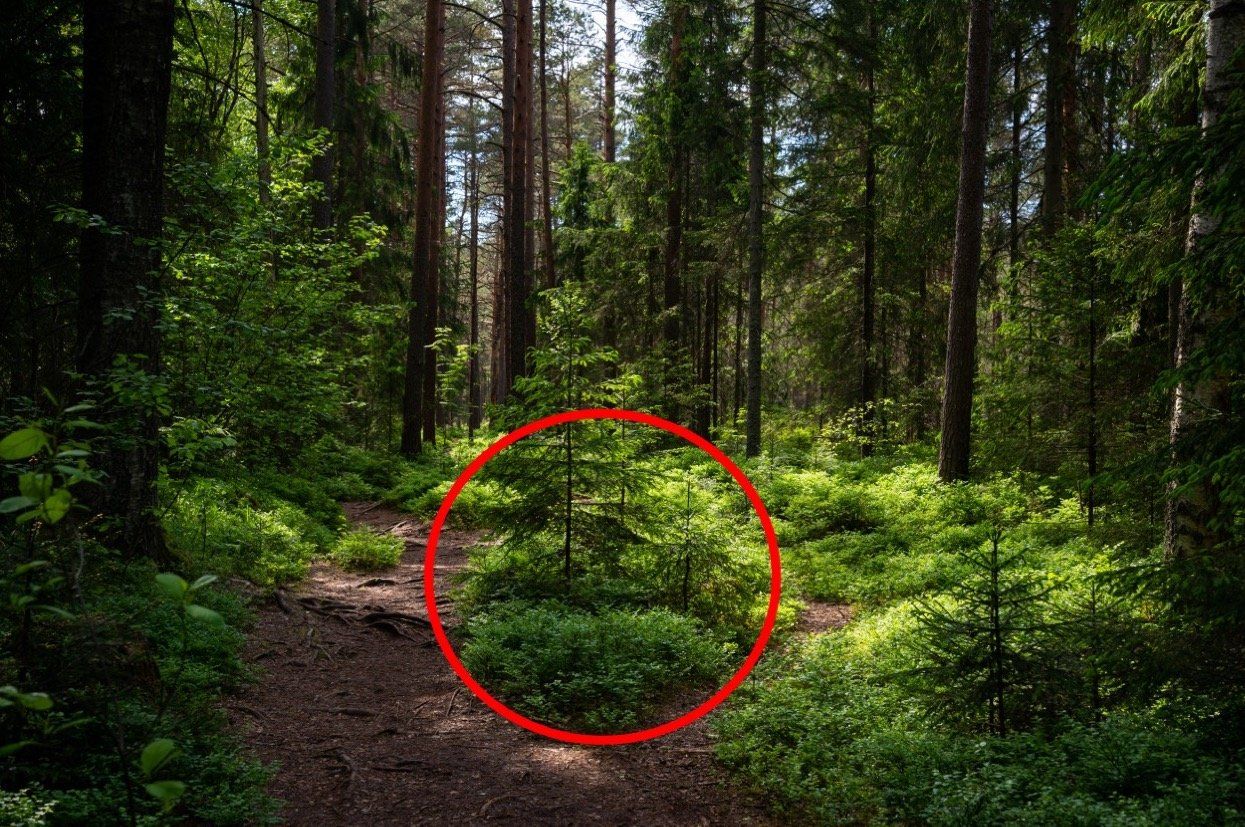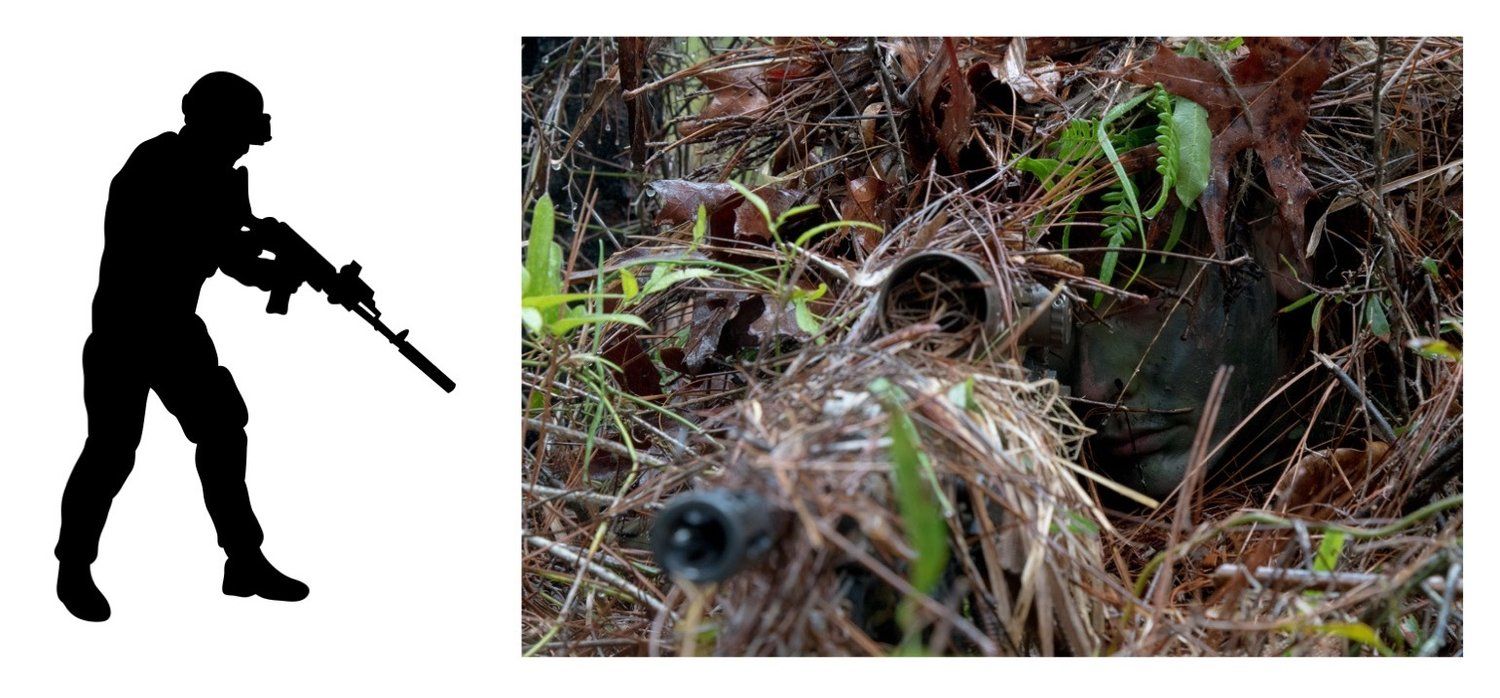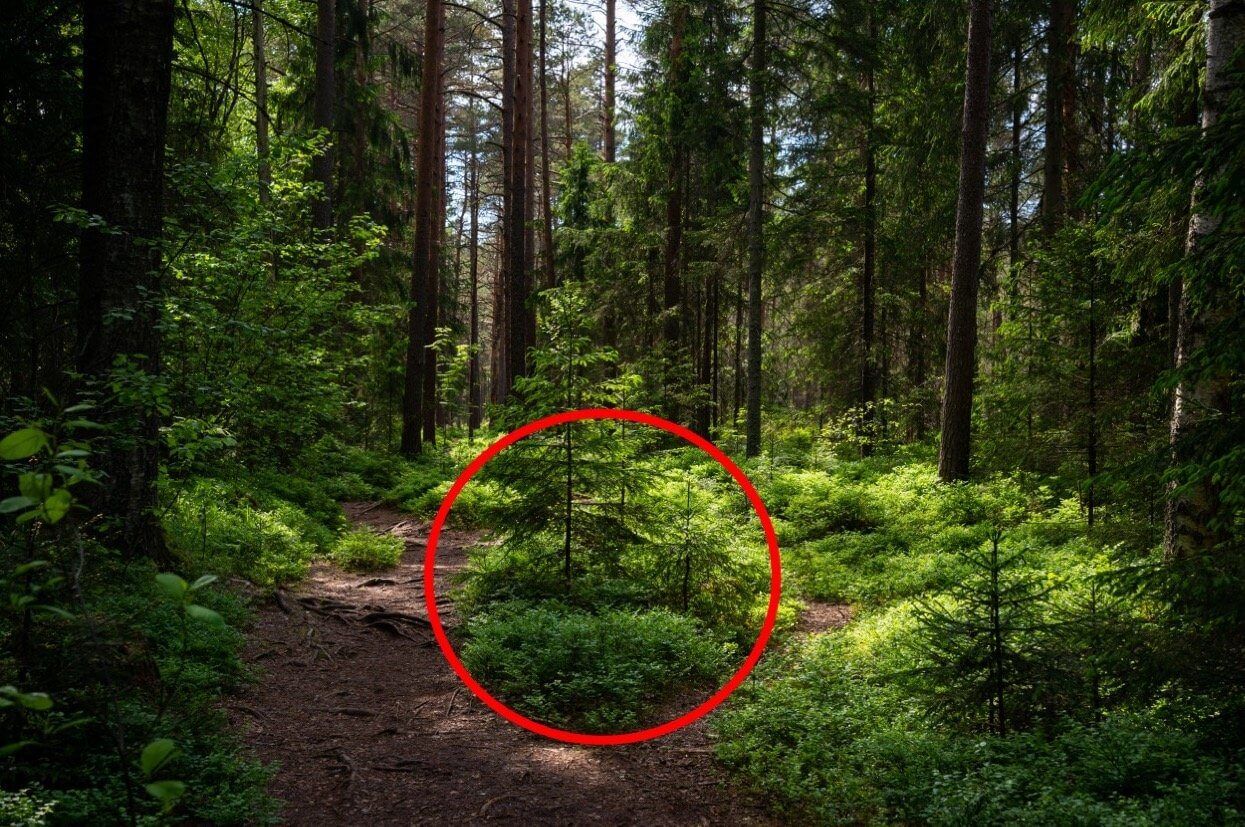Tactical Movement - Part 2

Individual Tactical Movement Part 2:
Situational Awareness
It is not sufficient to simply look for the enemy. Much critical time is often wasted by not knowing how and where to look.
As discussed in the previous article (Tactical Movement - Part 1), whenever you slow down or stop when moving near a piece of cover, you should focus on looking and listening for the enemy. However, to truly be effective at spotting enemies on the battlefield, you have to do a lot more than simply “keep your head on a swivel,” which is the limit of what is taught in most military schools.
When most people "keep their head on a swivel" they are subconsciously expecting to see the image on the lower left, the silhouette of an enemy trooper. However, in reality, a more skilled enemy will probably look more like the image on the lower right. The only way you are going to detect the threat on the lower right is not by spinning your head around on a swivel, but rather by knowing exactly where to look and focusing your attention on that spot to identify any small inconsistencies in color, shadow, outline, glare or movement.
As discussed in the previous article (Tactical Movement - Part 1), whenever you slow down or stop when moving near a piece of cover, you should focus on looking and listening for the enemy. However, to truly be effective at spotting enemies on the battlefield, you have to do a lot more than simply “keep your head on a swivel,” which is the limit of what is taught in most military schools.
When most people "keep their head on a swivel" they are subconsciously expecting to see the image on the lower left, the silhouette of an enemy trooper. However, in reality, a more skilled enemy will probably look more like the image on the lower right. The only way you are going to detect the threat on the lower right is not by spinning your head around on a swivel, but rather by knowing exactly where to look and focusing your attention on that spot to identify any small inconsistencies in color, shadow, outline, glare or movement.

How to Look for the Enemy - and What to Expect
When your head is on a swivel, you are looking at everything around you. However, most of what is around you is not worth too much attention, at least no more than a quick glance.
Open Areas
The image below shows a wooded area that is fairly open and free of vegetation. The thick trees provide good cover should you make unexpected contact with the enemy. There are several places where enemies could be hiding in this image, but there are also many places where the enemy is probably not hiding.

Unless you are facing an enemy that operates in tunnels or buries himself, there are most likely no threats in the open area (marked in red below) that is plainly visible around you. While you cannot completely ignore this area, you should focus your attention on areas where the enemy is more likely to be hiding.

Isolated Cover
Another place where threats are less likely to be hiding is behind pieces of isolated cover. The reason for this is because while isolated cover might offer good protection and concealment initially, it doesn’t provide any safe route of retreat. If you hide behind a piece of isolated cover when adversaries are close by, you are essentially stuck there and very vulnerable. It is only a matter of time before you get flanked. Most enemies will not want to put themselves in this kind of position.
Isolated cover also presents less of a threat because there are only so many people that can squeeze behind a single isolated tree, rock or log.
For all of these reasons, when searching for the enemy, you can focus less attention on (but not ignore) isolated cover. However, it is important to remember that not all enemies are well trained. Nor are all enemies rational, and some may have no fear of sacrificing themselves to kill a few members of your unit. Such enemies might have no problem hiding behind isolated cover, waiting for you to pass by and then opening fire, even though their chances of escape are minimal.
Therefore, depending on the environment and the nature of the enemy, you still may need to remain alert for potential threats hiding behind isolated cover.
Isolated cover also presents less of a threat because there are only so many people that can squeeze behind a single isolated tree, rock or log.
For all of these reasons, when searching for the enemy, you can focus less attention on (but not ignore) isolated cover. However, it is important to remember that not all enemies are well trained. Nor are all enemies rational, and some may have no fear of sacrificing themselves to kill a few members of your unit. Such enemies might have no problem hiding behind isolated cover, waiting for you to pass by and then opening fire, even though their chances of escape are minimal.
Therefore, depending on the environment and the nature of the enemy, you still may need to remain alert for potential threats hiding behind isolated cover.

Brush with No Cover
It is also less likely that enemies will hide in thick bushes that provide no actual cover or protection from bullets. There are several reasons for this.
First, smarter, more competent enemies will try to take advantage of both cover and concealment, not just concealment alone.
Second, finding a good prone firing position in very thick brush can be difficult. In most cases when you lie down, you won’t be able to see anything to your front because bushes are blocking your view. If you move forward to see more clearly, the bushes will no longer be masking your position. It can also be uncomfortable to lie down in thick brush for long periods and difficult/noisy to change positions or adjust your aim.
For all of these reasons, enemies will tend not to lie in the middle of bushes with no cover. However, skilled enemies can also camouflage carefully prepared, fortified positions to look like natural brush. Less skilled enemies may also hide behind bushes, even though doing so offers them little cover or observation. So, you must not completely discount bushes when searching for the enemy.
First, smarter, more competent enemies will try to take advantage of both cover and concealment, not just concealment alone.
Second, finding a good prone firing position in very thick brush can be difficult. In most cases when you lie down, you won’t be able to see anything to your front because bushes are blocking your view. If you move forward to see more clearly, the bushes will no longer be masking your position. It can also be uncomfortable to lie down in thick brush for long periods and difficult/noisy to change positions or adjust your aim.
For all of these reasons, enemies will tend not to lie in the middle of bushes with no cover. However, skilled enemies can also camouflage carefully prepared, fortified positions to look like natural brush. Less skilled enemies may also hide behind bushes, even though doing so offers them little cover or observation. So, you must not completely discount bushes when searching for the enemy.

Identifying the Most Likely Enemy Locations
Open/clear areas, isolated cover, and brush with no cover are just a few examples of places where the enemy is less likely to hide. As you search for the enemy, use common sense and past experience to anticipate locations where the enemy is most likely to be. Then, focus your attention on those areas carefully.
Look for small inconsistencies in color, shadow, outline, glare or movement. Look for disturbed earth, broken or disturbed branches, flattened grass, overturned leaves, moss scraped off rocks or trees etc. You may not be close enough to see such small details, but do your best to look for them.
Returning to the image below, having ruled out the less likely places where an enemy could be hiding, we can zero in on two areas that present more of a threat.
Look for small inconsistencies in color, shadow, outline, glare or movement. Look for disturbed earth, broken or disturbed branches, flattened grass, overturned leaves, moss scraped off rocks or trees etc. You may not be close enough to see such small details, but do your best to look for them.
Returning to the image below, having ruled out the less likely places where an enemy could be hiding, we can zero in on two areas that present more of a threat.

The two areas marked in green near the large fallen logs offer a combination of cover and concealment where several enemies could hide. It would also be easier for enemies hiding in these locations to pull back or break contact, particularly in the location on the left side. While skilled enemies know it is not always ideal to pop up and fire over a fallen log (because popping your head up over an object makes you easier to spot), they might stay low to the ground and shoot around the log. They might also use a combination of cover provided by the log and nearby trees, along with additional concealment offered by bushes.
This area around the two fallen logs is an example of the type of enemy position for which you should be looking. It is also important to remember that even if you do not spot the enemy before he opens fire, by using the techniques just described you will have a much better chance of pinpointing the enemy after he opens fire.
In many cases, when infantry units come under fire it takes a while to identify where the fire is coming from. This process is much quicker if you are already expecting the fire to come from specific locations and know where to look.
This area around the two fallen logs is an example of the type of enemy position for which you should be looking. It is also important to remember that even if you do not spot the enemy before he opens fire, by using the techniques just described you will have a much better chance of pinpointing the enemy after he opens fire.
In many cases, when infantry units come under fire it takes a while to identify where the fire is coming from. This process is much quicker if you are already expecting the fire to come from specific locations and know where to look.
Planning Your Immediate Action Response
Once you determine the locations where the enemy is most likely to be hiding, you should use that information to help you decide where to seek cover should you take fire from those locations.
You may choose to alter your path towards a different piece of cover that offers better protection from the direction of greatest threat.
In some cases, you might identify two pieces of cover, one that provides better protection against fire from the right and one that offers better protection against fire from the left. The more you use your brain, anticipate enemy actions and prepare to react quickly, the greater your chances of survival should you come under fire.
However, it is also critical not to overthink the situation and try to pre-plan every action in response to every possibility. When you first practice going through the process explained in these two articles, including moving from cover-to-cover, looking for the enemy and planning your reactions accordingly, you might feel overwhelmed or confused, just as firing a weapon might have seemed awkward the first time you went to the range. The goal is for all of these thoughts and actions to become instinctive or second nature, much like shooting.
When you walk by a potential threat area to your left, you will instinctively feel exposed and feel pulled towards a piece of cover that protects you from that direction. The goal is to develop a “game sense” for combat just as skilled athletes develop a game sense for their chosen sport.
You may choose to alter your path towards a different piece of cover that offers better protection from the direction of greatest threat.
In some cases, you might identify two pieces of cover, one that provides better protection against fire from the right and one that offers better protection against fire from the left. The more you use your brain, anticipate enemy actions and prepare to react quickly, the greater your chances of survival should you come under fire.
However, it is also critical not to overthink the situation and try to pre-plan every action in response to every possibility. When you first practice going through the process explained in these two articles, including moving from cover-to-cover, looking for the enemy and planning your reactions accordingly, you might feel overwhelmed or confused, just as firing a weapon might have seemed awkward the first time you went to the range. The goal is for all of these thoughts and actions to become instinctive or second nature, much like shooting.
When you walk by a potential threat area to your left, you will instinctively feel exposed and feel pulled towards a piece of cover that protects you from that direction. The goal is to develop a “game sense” for combat just as skilled athletes develop a game sense for their chosen sport.

©Copyright Special Tactics, LLC. Published with permission.
Iron Survival, LLC
Featured links
Policy Pages
©Copyright 2026 Iron Survival, LLC
